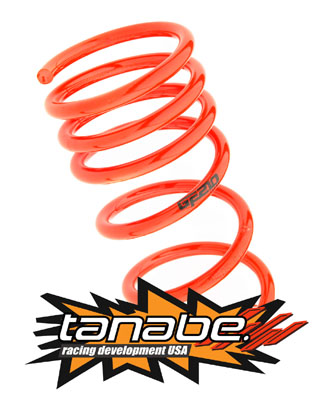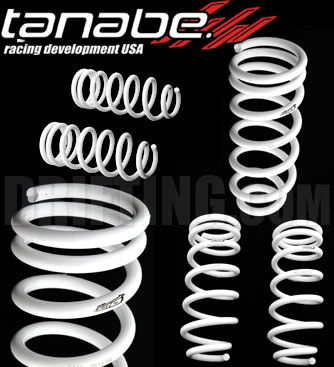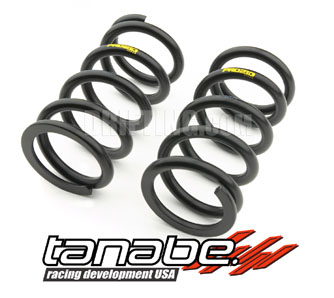Suspension 101: Stiffer is Better?
Text by Michael McFall, Tanabe Racing Development, USA
Photographs by DRIFTING.com
Car club meetings and car shows are home to a strange, if not disturbing phenomenon. Perhaps it’s a guy thing, or subconsciously the end result of an environment that constantly tells us to buy enlargement pills online for cheap. If you’ve been to one of these ‘meets’, you’ve more than likely been witness to these bizarre occurrences. A group of people standing around a car will be looking down, excitedly pushing down on something, and then one person will look up; wild eyed, and comment “hey, that’s pretty stiff!” It’s not really something you would want to hear out of context; like say, in the men’s bathroom. Now that our minds are in the right place, it’s time to tear apart this preconception many of us have about having a stiff ride.

“So how stiff is it?” This question is akin to going to a used car lot and kicking the tire to see if it’s a good car. The question isn’t completely without merit, but it’s in the context that we find its true purpose.
Why do people want stiff suspensions? What is it, and what does it do?
While I can’t wholly answer why many people desire a rock-hard suspension package for a daily car, I do have a feeling it is Napoleonic in nature. People typically upgrade their suspension so their car can handle better. In The Basics - Handling section that is coming soon we will learn that loosely, handling is simply a matter of traction. (aka putting rubber to road.) Traction lets us do all sorts of fun things, on many different kinds of road surfaces. Naturally, different suspensions perform better under different conditions—lets take a general look at some different kinds of roads:
City Streets – Constantly changing from smooth even surfaces, to bumpy an horribly uneven.
Highways – Typically smooth and even, with an occasional bump here and there.
Mountain Roads – Elevation changes, debris, and other road anomalies (this includes animals!)
Raceways – Immaculately smooth and grippy tarmac, the perfect road condition!
Let’s see how a high spring rate uber stiff suspension handles on these types of roads. (dampeners should always be mated with the spring rate, and never exceed it!)
Putting ‘Stiff’ to the test:
City Streets – Constantly changing from smooth even surfaces, to bumpy an horribly uneven.

On the smooth surfaces the car will handle nice, and your tyte ryde will look pretty hot slammed with that new aero kit and blingin rims. Once you take that right turn onto a bumpy street, the ride quality can become unbearably rough as the car jostles and bounces all over the place. This can cause hernias, headaches, and possibly even a break-up with your significant other as your passengers will HATE YOU.
On a serious note, if you have to brake hard or take a turn on a bumpy road, the springs which are meant to absorb the bump, will not perform their function and you will lose traction. This is very dangerous and can cause you to get into a serious accident.
Highways – Typically smooth and even, with an occasional bump here and there.
Luckily, most highways are very smooth. Occasionally you do get the occasional bump, but for the most part you will have a very smooth stable ride. You will be able to take that nice long sweeper at a nice speed and not have to sweat it.
Conversely, if you hit that bump taking that long sweeper at a high speed, you could essentially lose [traction] and under/oversteer into the center divider, provided there is one.
Mountain Roads – Elevation changes, debris, and other road anomalies (this includes animals!)
Stiff suspensions and mountain roads do not mix. Take the bad situations of City and Highway and multiply it by ONE MILLION. Mountain Roads are generally not well maintained, so that 2000 dollar racing suspension is really going to work against you here. The car will be bouncing from the bumps, as the springs will not absorb them. Weight is going to be transferring all over the place, so you’re going to need as much grip as you can get.
Braking under rough road conditions will more than likely cause an understeer condition. Barreling through a turn on a rough road will cause understeer, or oversteer. If you have to brake hard to avoid an animal and the road is rough…you can kiss your Takumi aspirations goodbye as you plow into that Initial Deer.
Raceways – Immaculately smooth and grippy tarmac, the perfect road condition!
Ahh, the raceway. If all roads could be so immaculately maintained, I would drive a racecar everyday. My daily driver is a ’92 Geo Storm, unfortunately. Anyhow, the stiff suspension really shines on the track, because ‘duh!’ that is what it was built for! A stiff suspension, with the combination of a [GOOD DRIVER] and great tires will result in amazing lap times and fun times, indeed.
There is a limit to how stiff you can go, but on the raceway, most of us will never reach that point or would be able to afford it.

Final Thoughts
So the ultra stiff suspension wasn’t all that it was made out to be. It’s like that scene in “A Christmas Story” where the young hero uses his decoder ring only to find out that it was all just a scheme to drink more chocolate milk. Race suspensions do have their place on race cars, but for street cars, it is best and safer to have something a bit softer. The softer suspension will actually outperform the race suspension outside of the track, and there are plenty of options available for the discriminating driver to choose from.
Remember, a suspension is only as good as the driver. 99% of the time, we are not driving on a track, so finding a good balance for your needs and budget is the key. The best suspension upgrade is upgrading the driver. It’s “how you use it”.
Related Links:
Street Suspension
Sustec GF210
Sustec DF210
Sustec NF210
Street/Track Suspension
Sustec Pro S-0C
Sustec Pro S-S
Circuit Suspension
Sustec Pro RR
Sustec Pro DD
http://tanabe-usa.com
Text by Michael McFall, Tanabe Racing Development, USA
Photographs by DRIFTING.com
Car club meetings and car shows are home to a strange, if not disturbing phenomenon. Perhaps it’s a guy thing, or subconsciously the end result of an environment that constantly tells us to buy enlargement pills online for cheap. If you’ve been to one of these ‘meets’, you’ve more than likely been witness to these bizarre occurrences. A group of people standing around a car will be looking down, excitedly pushing down on something, and then one person will look up; wild eyed, and comment “hey, that’s pretty stiff!” It’s not really something you would want to hear out of context; like say, in the men’s bathroom. Now that our minds are in the right place, it’s time to tear apart this preconception many of us have about having a stiff ride.

“So how stiff is it?” This question is akin to going to a used car lot and kicking the tire to see if it’s a good car. The question isn’t completely without merit, but it’s in the context that we find its true purpose.
Why do people want stiff suspensions? What is it, and what does it do?
While I can’t wholly answer why many people desire a rock-hard suspension package for a daily car, I do have a feeling it is Napoleonic in nature. People typically upgrade their suspension so their car can handle better. In The Basics - Handling section that is coming soon we will learn that loosely, handling is simply a matter of traction. (aka putting rubber to road.) Traction lets us do all sorts of fun things, on many different kinds of road surfaces. Naturally, different suspensions perform better under different conditions—lets take a general look at some different kinds of roads:
City Streets – Constantly changing from smooth even surfaces, to bumpy an horribly uneven.
Highways – Typically smooth and even, with an occasional bump here and there.
Mountain Roads – Elevation changes, debris, and other road anomalies (this includes animals!)
Raceways – Immaculately smooth and grippy tarmac, the perfect road condition!
Let’s see how a high spring rate uber stiff suspension handles on these types of roads. (dampeners should always be mated with the spring rate, and never exceed it!)
Putting ‘Stiff’ to the test:
City Streets – Constantly changing from smooth even surfaces, to bumpy an horribly uneven.

On the smooth surfaces the car will handle nice, and your tyte ryde will look pretty hot slammed with that new aero kit and blingin rims. Once you take that right turn onto a bumpy street, the ride quality can become unbearably rough as the car jostles and bounces all over the place. This can cause hernias, headaches, and possibly even a break-up with your significant other as your passengers will HATE YOU.
On a serious note, if you have to brake hard or take a turn on a bumpy road, the springs which are meant to absorb the bump, will not perform their function and you will lose traction. This is very dangerous and can cause you to get into a serious accident.
Highways – Typically smooth and even, with an occasional bump here and there.
Luckily, most highways are very smooth. Occasionally you do get the occasional bump, but for the most part you will have a very smooth stable ride. You will be able to take that nice long sweeper at a nice speed and not have to sweat it.
Conversely, if you hit that bump taking that long sweeper at a high speed, you could essentially lose [traction] and under/oversteer into the center divider, provided there is one.
Mountain Roads – Elevation changes, debris, and other road anomalies (this includes animals!)
Stiff suspensions and mountain roads do not mix. Take the bad situations of City and Highway and multiply it by ONE MILLION. Mountain Roads are generally not well maintained, so that 2000 dollar racing suspension is really going to work against you here. The car will be bouncing from the bumps, as the springs will not absorb them. Weight is going to be transferring all over the place, so you’re going to need as much grip as you can get.
Braking under rough road conditions will more than likely cause an understeer condition. Barreling through a turn on a rough road will cause understeer, or oversteer. If you have to brake hard to avoid an animal and the road is rough…you can kiss your Takumi aspirations goodbye as you plow into that Initial Deer.
Raceways – Immaculately smooth and grippy tarmac, the perfect road condition!
Ahh, the raceway. If all roads could be so immaculately maintained, I would drive a racecar everyday. My daily driver is a ’92 Geo Storm, unfortunately. Anyhow, the stiff suspension really shines on the track, because ‘duh!’ that is what it was built for! A stiff suspension, with the combination of a [GOOD DRIVER] and great tires will result in amazing lap times and fun times, indeed.
There is a limit to how stiff you can go, but on the raceway, most of us will never reach that point or would be able to afford it.

Final Thoughts
So the ultra stiff suspension wasn’t all that it was made out to be. It’s like that scene in “A Christmas Story” where the young hero uses his decoder ring only to find out that it was all just a scheme to drink more chocolate milk. Race suspensions do have their place on race cars, but for street cars, it is best and safer to have something a bit softer. The softer suspension will actually outperform the race suspension outside of the track, and there are plenty of options available for the discriminating driver to choose from.
Remember, a suspension is only as good as the driver. 99% of the time, we are not driving on a track, so finding a good balance for your needs and budget is the key. The best suspension upgrade is upgrading the driver. It’s “how you use it”.
Related Links:
Street Suspension
Sustec GF210
Sustec DF210
Sustec NF210
Street/Track Suspension
Sustec Pro S-0C
Sustec Pro S-S
Circuit Suspension
Sustec Pro RR
Sustec Pro DD
http://tanabe-usa.com



Comment